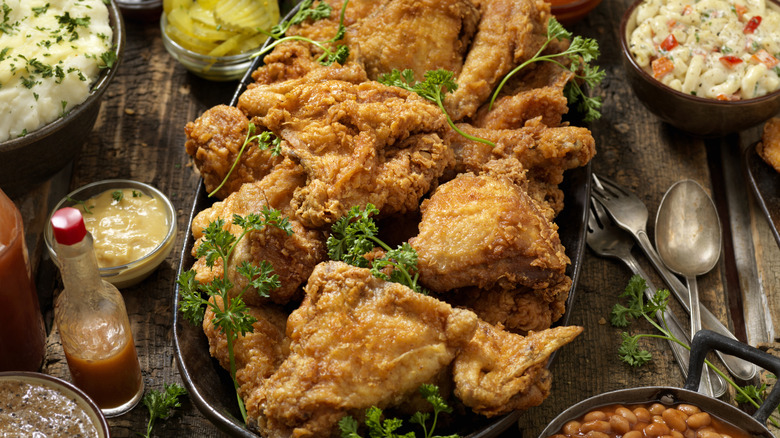Why Using A Deep Pot For Fried Chicken Is A Huge Mistake
The art of fried chicken involves a lot of things, from generational family secrets to handed-down cast-iron skillets and a penchant for traditional comfort foods. In some communities, mastering a chicken "fry up" is considered a rite of passage into the world of culinary competence. Anyone raised in the American South gets a head-start in that scenario, since fried chicken reaches kitchen-cult status in its many incarnations — from country-fried chicken to Nashville hot, bite-sized popcorn, and the most famous of them all, Kentucky Fried.
However, the myth, magic, and mastery of fried chicken isn't quite as elusive as you may think. It really comes down to a handful of understandings, mostly involving technique, especially what kind of pan to use. Great-granny's cast-iron skillet survives decades of use for many reasons, not the least of them its wide shape, relatively shallow depth, and easy accessibility to that sizzling chicken. Using a deep pot for fried chicken is a major mistake, since it's harder to manage the chicken pieces for turn times and crispy perfection.
Since chicken pieces for frying have been coated in flour, they'll tend to clump together if bobbing around in the hot oil of a deep pot. With a frying pan, those flour-dredged pieces can be carefully monitored and separated, cradled by the sturdy bottom and sides. The pan also encourages a crispier crust for the ultimate fried chicken dinner.
Other kitchen faux pas when frying chicken
Deep pots for frying chicken have more than a few drawbacks, at least when making the traditional, legendary country-fried chicken. In addition to hindering access for just-in-time chicken flipping, a large, deep pot requires far more oil. That's a cost-hogging disadvantage with no real benefit, plus there's the chore of disposing of the excess used oil before it goes rancid. Chicken that's fried in a deep pot can also absorb more of that oil, increasing the risk of a soggy crust and oily chicken.
Using a deep pot for frying chicken isn't unheard of — it's in fact a well-known cooking concept called "deep frying," whether for chicken, fish, vegetables, or whatever you feel like battering and dropping into a vat of hot oil. It's common especially for an outdoor neighborhood "fish fry," which is another longtime Southern tradition of frying catfish for gatherings of friends and neighbors.
Using a frying pan for chicken, ideally one made of cast iron, turns it into "pan frying" but with a twist. You'll use a bit more oil in the pan, enough to keep the chicken pieces half-in and half-out of the oil as they fry, flipping halfway through. Maintaining a medium cooking heat allows each submerged side of chicken to thoroughly cook without burning the crust. To keep the meat from drying out, cover the pan with a lid, which traps moisture inside while ensuring even heat and crispier texture.

